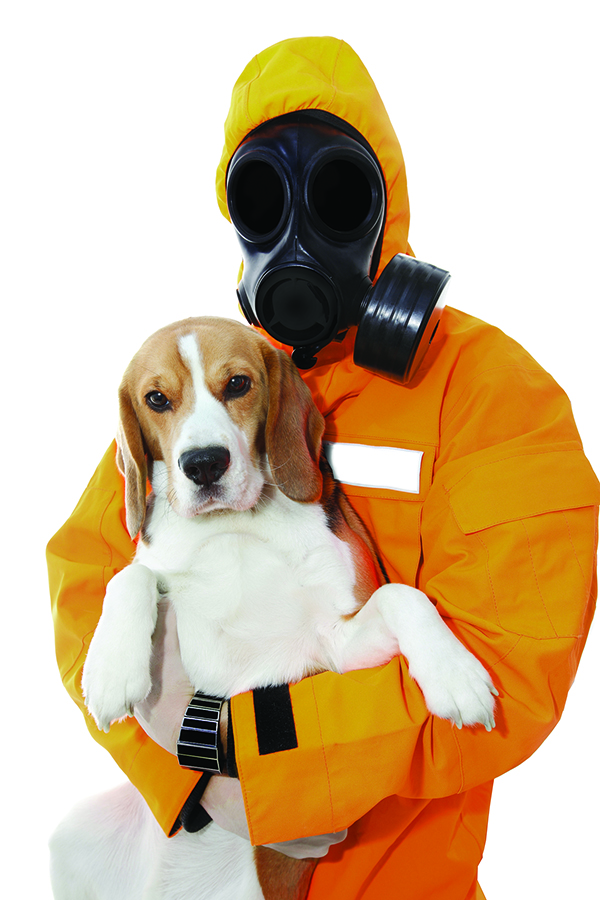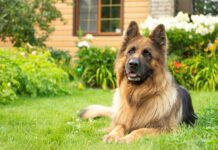
Oh, my. What’s that smell? If your dog is in the room, it could be really bad breath, dreadful flatulence, leaking anal glands, skunk residue, malodorous dandruff, infected ears, wet dog odor, urine from scent marking, vomit, diarrhea, or something your pup recently rolled in, like manure, dead fish, or well-rotted mammal parts.
Some offending fragrances can be sprayed or washed away, but for others you’ll need more than a deodorizing air spritz. Here’s a look at what can help your dog, yard, house, and kennels smell better, with an emphasis on safe-to-use products that remove unpleasant odors at their source rather than those that cover unpleasant smells with perfumes or other strong scents.
MY DOG JUST STINKS
If your dog seems to smell bad all the time, schedule an appointment with your veterinarian to rule out medical conditions that contribute to unpleasant smells.
For example, canine body odors can be warning signs of cancer, urinary tract infections, parvovirus, or infections caused by bacteria, yeast, or parasites.
One obvious candidate for change is your dog’s diet. Switching to a higher-quality food – which usually means upgrading to better quality protein – may be all that’s needed. WDJ is famous for guiding readers through the world of raw, cooked, fresh, frozen, dried, dehydrated, canned, home-prepared, and commercial pet foods and treats. No matter what your budget, you can improve your dog’s overall health and body odor by feeding the best you can afford. Search the archives or click on “Dog Food Information” at wholedog-journal.com.
WILL SUPPLEMENTS HELP?
Probiotics are “friendly” gut bacteria that make up the dog’s microbiome and form a first line of defense against pathogens (see “A Better Biome,” February 2018). Prebiotics nourish probiotics and help maintain healthy populations of beneficial microorganisms. Enzymes such as protease, bromelain, and papain (which break protein into amino acids), amylase (which digests carbohydrates), and lipase (which breaks down fats) help prevent foul odors by assisting digestion.
Researchers disagree about whether these supplements are necessary, but users of probiotics, prebiotics, and digestive enzymes often report a reduction in symptoms like itching, scratching, bad breath, body odors, excessive shedding, dry or flaky skin, recurring ear infections, diarrhea, and loose or malodorous stools. (See “We’re ‘Pro’ Probiotics,” March 2012; “Praise for Prebiotics,” April 2012; and “Improving Digestion: Digestive Enzyme Supplements,” May 2012.)
Chlorophyll, a green plant pigment that became popular in the 1950s as a whole-body deodorizer said to work from the inside out, can be added to a dog’s food as a liquid or powdered supplement derived from chlorella, spirulina, wheat grass, or other green plants (follow label directions), or add finely minced fresh wheatgrass, parsley, mint leaves, or dandelion greens in small amounts, gradually increasing to 1 teaspoon per 20 pounds of body weight. (Parsley is not recommended during pregnancy.)
Coconut oil, which has proven anti-bacterial, anti-fungal, and antiviral properties, has been promoted as a deodorizing supplement for dogs. While no clinical trials have tested those claims, coconut oil enthusiasts report improved skin, coat, and breath odor in dogs who receive small amounts in their food.
Start with 1/8 teaspoon per day for small dogs or puppies and 1/2 teaspoon for large dogs. Gradually increase the amount every few days to the optimum dose, about 1 teaspoon per 30 pounds of body weight daily, or 1 tablespoon per 100 pounds.
Introduce coconut oil in small amounts in divided doses, and reduce the amount or stop feeding it if your dog seems uncomfortable or has diarrhea. For more, see “Crazy about Coconut Oil,” WDJ October 2005.
ROUTINE MAINTENANCE
While long-haired dogs need more frequent brushing than dogs with short coats, brushing distributes the natural oils and releases dirt in any coat. Daily inspections make it easy to remove burrs, weed seeds, and parasites such as fleas or ticks. Check with a highly recommended local groomer to find the right combs or brushes for your dog. Removing tangles as soon as they develop helps prevent matting, which, if neglected, contribute to body odors by trapping skin-infecting bacteria.
Spraying your dog with a coat deodorizer or using deodorizing pet wipes may make a difference, especially after swimming. Dozens of products sold for home and salon use are described as “between bath” treatments that help your dog’s coat look and smell better. Some are called dry shampoos or waterless bathing sprays, and while most are scented, a growing number are fragrance-free.
Most product instructions say to spray or wipe a dog’s coat starting behind the ears (avoid the eyes) and work toward the tail. Massage to distribute, repeat if necessary, let dry, and then brush.
When your dog rolls in something awful or is just due for a shampoo, it’s time for the tub. The frequency of your dog’s need for bathing depends on her activities, coat condition, and body odor. For best results, groomers recommend diluting shampoos and conditioners, using more water than product. Repeat, then rinse thoroughly.
The faster a dog’s coat dries, the better he’s likely to smell. Short hair can dry quickly with towel rubbing and fresh air, while long, dense coats may need a professional groomer’s high-velocity dryer. When you’re on your own, use a large supply of the most absorbent towels available.
STINKY BREATH
An estimated 80 percent of companion dogs develop periodontal disease by age 2, and resulting toxins that drain from the mouth to the rest of the body contribute to systemic diseases of the kidneys, liver, and heart.
You can do a lot to prevent gum disease by brushing your dog’s teeth daily with a toothpaste formulated for dogs (never use human toothpaste). If you can manage just a little brushing, concentrate on the outer surfaces of the dog’s molars, where most of the tartar accumulates.
Many dog owners swear by the practice of feeding raw meaty bones to their dogs. “I can often tell at a glance whether a dog chews on raw bones,” says Tia Nelson, DVM, in Helena, Montana. “Bone-chewing dogs generally have better oral health, better smelling breath, and healthier gums. I believe it’s from the stimulation of the entire oral cavity that occurs when dogs chew bones. They should be appropriate to the dog’s size; and bones that are small enough for the dog to swallow whole should be avoided.” Note that dried bones, such as those found on pet-store shelves, are never recommended, as they are too hard and may break teeth.
Chronic bad breath may point to gum disease and other oral health problems but not always. See “Bad Dog Breath? Maybe Not!” July 2018, for problems incorrectly assumed to involve dental disease.
Pet-water additives sold as breath fresheners claim to enhance digestive health, improve nutrient absorption, and help dogs smell better all over. A small amount, such as a capful, is added to every bowl of drinking water (but always offer plain water, too). Some contain probiotics, digestive enzymes, micronized minerals, or ingredients known to minimize plaque and tartar buildup.
Unfortunately, some of these products contain xylitol, a sweetener that is toxic to dogs. While the small amounts used according to label directions are considered safe for dogs, some veterinarians are concerned that the daily ingestion of xylitol may pose a risk. Check labels and company websites for information and avoid products with xylitol or undisclosed ingredients. Oxyfresh is an example of a product that lists its ingredients and contains no xylitol.
Success with drinking water additives often depends on how they are introduced to your dog. Start with smaller-than-recommended quantities and respect your dog’s preferences.
SMELLY EARS
In addition to smelling bad, canine ear infections are painful and deserve a visit to your veterinarian for help. But by checking your dog’s ears frequently and keeping them clean with a safe ear rinse (see “Prevent Ear Infections by Cleaning Your Dog’s Ears,” April 2021), you can make your dog’s ears inhospitable to yeast and bacterial overgrowths. Avoid potentially painful ear rinses that contain vinegar or alcohol when treating chronic inflammations or ulcerated ear canals.
Here’s an ear rinse that’s safe, effective, and easy to make: Combine 1/8 teaspoon therapeutic-quality lavender essential oil with 3/4 cup distilled witch hazel, 1 tablespoon powdered boric acid, and 1/4 cup pure aloe vera juice or gel. Shake well before applying.
Another is Jake’s Remedy, an aromatherapy product designed to treat itchy skin and paws, hot spots, dry skin, hair loss, fungus, and ring worm. Jake’s Remedy works well as a soothing ear flush when applied with an eye dropper.
MY DOG GOT SKUNKED
Skunk-spray odor ranks as one of our most-disliked odors and it seems to last forever. That’s because the spray’s thiols and thioacetates, which are natural sulfur-containing chemicals, bind to other molecules, making them easy to spread and difficult to eliminate. Anything your skunked dog touches will get skunked, too.
Canned tomato juice and vinegar are traditional treatments that dog lovers still use, but neither neutralizes those annoying thiols and thioacetates. In addition to not working well, tomato juice can change the color of white or light-colored coats, and vinegar has its own distinctive odor.
Fortunately, there’s a home remedy that does the job. Mix 1 quart of 3% hydrogen peroxide (the kind that’s sold in grocery stores and pharmacies) with 1/4 cup baking soda and 1 teaspoon liquid dish soap. The mixture is chemically unstable, so it can’t be made in advance (closed containers can explode), so keep a supply of the ingredients on hand for skunky events.
Wearing protective gloves and avoiding your dog’s mouth and eyes (it stings!), massage this soupy mixture into your dog’s coat. Because the chemical reaction is instantaneous, and because prolonged exposure can bleach dark coats, fabrics, wood, and other porous surfaces, don’t leave it on your dog for more than a minute or two. Rinse well, shampoo, and rinse again. In most cases, a single treatment is all you’ll need, but repeat the procedure if necessary.
Other products recommended for de-skunking pets include:
• Nature’s Miracle Skunk Odor Remover. The company says this product “binds with and removes odors using a bio-enzymatic formula.”
• Skout’s Honor Skunk Odor Eliminator. The company says it “breaks down odor molecules with a plant-derived surficant and molecular deodorizer.”
• Alpha Tech Pet Skunkaway. The company says that when combined with water, the product “creates a chain reaction that disassembles odor molecules and reassembles them in an odor-free matrix.”
Many dog-deodorizing products claim to be made of natural or naturally derived ingredients, but while all-natural products may be safer for dogs and puppies, they don’t necessarily work better than products containing synthetic ingredients.
And what does “natural” really mean? Polysorbate 20 may be listed as a natural ingredient, but it’s an FDA-approved synthetic flavoring agent. DMDM hydantoin is an organic compound found in hair care products, where it acts as a preservative by releasing formaldehyde. Sodium cocyl gluamatae and other cocyl ingredients are derived from coconut oil, though they are very different from that source material.
More controversial are ingredients like sodium lauryl sulfate, petroleum-based fragrances and phthalates, synthetic dyes, parabens, and isothiazolines, which have been criticized for being harsh on skin, potentially toxic, disruptive to hormones, or damaging to marine environments.
Some labels list what products don’t contain, such as sulfate-free, alcohol-free, xylitol-free, detergent-free, paraben-free, no triclosan, no mineral oil, no petrolatum, no drethanolalamine (DHA), no phthalates, no chlorhexidine, no propylene glycol, or no added colors or dyes.
By itself, the presence or absence of natural or synthetic ingredients doesn’t determine whether a product will work well for your dog, so check product reviews, consult groomers and other experts, and keep notes as you experiment.
Most of the manufacturers mentioned here welcome customer questions, provide educational information, and offer money-back guarantees. The dog-deodorizing industry, already enormous, continues to grow.
FRESH SURROUNDINGS
Some of the most interesting and versatile deodorizing products are fragrance-free odor removers derived from natural sources. Read labels carefully because some products are designed for use on pet bedding or other surfaces but not for application on pets. Most of them dry odor-free but may contain a rapidly evaporating tracer fragrance to help users identify treated areas.
Natures Odor Control or N.O.C. products contain amino acids, vitamins, and trace minerals derived from a culture of blue-green algae. Liquid N.O.C. products become active for eight hours when mixed with water. Recommended applications include the treatment of vomit, urine, feces, and other unpleasant odors. N.O.C.’s dry granules can also be used to neutralize odors. Its Pet Powder is brushed or massaged into the dog’s coat for improved body odor; it’s also indicated for eliminating skunk spray.
Odor-B-Gone products eliminate skunk scent on animals, urine odors on concrete floors, and odors trapped in carpets, upholstered furniture, and bedding, using an extract derived from yucca plants. Its Spot Stain and Odor Remover releases and removes tough stains, even old ones.
Zero Odor says its spray products “use molecular technology to bind with odor molecules in the air and on surfaces, transforming them into odorless molecules.” While the company says these products are safe for use on dog beds, collars, and other equipment, they are not recommended for direct application on dogs.
Bac-Out Stain and Odor Remover by Biokleen combines live enzyme cultures, citrus extracts, and plant-based surficants to deodorize pet accidents and more. Apply, let stand for at least five minutes, then blot with a clean cloth. Not recommended for direct application on pets.
Simple Green Outdoor Odor Eliminator uses natural enzymes to eliminate odors at their source on grass, turf, gravel, concrete, and outdoor carpets. The bottle features a hose attachment for easy outdoor spray application. This is a scented product. It is not recommended for direct application on pets.
DID YOU JUST FART?

Jokes aside, flatulence can result from gastrointestinal problems, so if the problem is chronic, check with your veterinarian, in case it results from food sensitivities, irritable bowel syndrome, parasites, pancreatic disorders, or other sources of inflammation.
Sweetening your otherwise healthy dog from the inside out takes us back to diet. Try upgrading protein sources, experimenting with meat-based, low-carbohydrate foods, and staying away from frequently blamed ingredients like soy, corn, wheat, and dairy products. In addition, adding probiotics, prebiotics, and enzymes to food can reduce flatulence by improving your dog’s digestion.
Deodorizing dietary additions such as chlorophyll supplements or finely minced green herbs may help, as can “carminative herbs.” Ingesting the latter relaxes stomach muscles and relieves intestinal gas. Ginger, fennel, dill, cayenne, thyme, and peppermint are widely used examples of carminitive herbs. Sprinkle small amounts of dried or freshly minced carminatives on your pet’s food to see if they make a difference.
If your dog eats everything in a hurry, she may swallow air along with her dinner, which worsens the problem (and can cause bloat). Slow her down by placing a large obstacle in her bowl, or try feeding her from a specially designed dog dish, snuffle mat, or other arrangement that slows food consumption (see “Savor the Flavor,” November 2020 for a review of slow-feeder products). In multiple-dog households, try feeding dogs in separate rooms to reduce competition that results in gulping.
And when gas happens, be ready to spray the air with a fragrance-free odor eliminator.
LEAKING ANAL GLANDS
Now there’s an unforgettable fragrance. Dogs who scoot on, lick, or even bite their hind ends may be trying to relieve the heat, inflammation, swelling, and pain of impacted anal glands as well as the abscesses (bacterial infections) they can produce.
Overweight, sedentary, and small-breed dogs are more frequently plagued by anal gland problems, but the issue can develop in physically active, slender, and otherwise healthy dogs of all breeds and sizes. If your dog appears to be in pain or is obsessed with licking under his tail, make an appointment with your veterinarian to make sure your dog doesn’t have a ruptured or infected anal gland.
Some veterinarians and groomers consider manual expression (pressing on both sides of the anal glands to release their contents) a routine treatment while others discourage that approach. Whether you do or don’t express your dog’s anal glands,preventive measures like increasing his active exercise and dietary fiber intake may help. Deodorize bedding and other affected surfaces with appropriate products, some of which (check labels) are safe for direct application to your dog’s anal area.
• Alpha Tech Pet Odor products, alphatechpet.com; (800) 222-5537
• Bac-Out Stain and Odor Remover, biokleenhome.com; (800) 477-0188
• Jake’s Remedy, FrogWorks, frogworks.us; (303) 973-8848 (this number has been corrected)
• Nature’s Miracle Skunk Odor Remover and other pet odor products, naturesmiracle.com; (800) 645-5154
• Nature’s Odor and Germ Control pet products, nogc.com; (888) 884-6367
• Odor-B-Gone Odor Eliminator products, odorbgoneproducts.com; (800) 433-9039
• Oxyfresh Pet Dental Water Additive, oxyfresh.com; (800) 333-7374
• Simple Green Outdoor Odor Eliminator, simplegreen.com; (800) 228-0709
• Skout’s Honor Skunk Odor Eliminator and grooming products, skoutshonor.com; (877) 805-0399
• Zero Odor Deodorizing Products, zeroodor.com; (800) 526-2967





My dog just started on 1/8 tsp of an enzymatic powder, placed on his food 15 minutes before eating. The powder stinks, and now my dog stinks- almost like ammonia. HELP! I am losing my dog-sitter it has become so nasty. He weighs 5lbs, Yorkie. Thx.